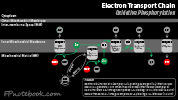High Energy Molecule, Adenosine Triphosphate, ATP, Adenosine Diphosphate, ADP, Guanosine Triphosphate, GTP, Uridine Triphosphate, Phosphocreatine, Creatine Phosphate, Nicotinamide Adenine Dinucleotide, NADH, Nicotinamide Adenine Dinucleotide Phosphate, NADPH, Flavin Adenine Dinucleotide, FADH2, Coenzyme A, Acetyl Coenzyme A, Tetrahydrofolate, Tetrahydrofolic Acid, Dihydrofolic acid, Thiamine Pyrophosphate, S-Adenosylmethionine, Uridine Diphosphate Glucose, UDP Glucose, Oxidative Phosphorylation, Electron Transport Chain
- See Also
- Mechanism
- Energy Transfer
- Oxidative Phosphorylation (Electron Transport Chain)

- Reaction cascade that converts Kreb Cycle energy from NADH and FADH to ATP
- Cytochrome based process within the mitochondria
- Oxygen dependent process (oxidation) coupled to phosphorylation of ADP to ATP
- When this process is uncoupled (e.g. uncoupler, hibernation), rare in humans, heat is generated
- Types
- Phosphoryl Transferring High Energy Molecules
- Adenosine Triphosphate (ATP/ADP)
- Adenine Nucelotide (sugar molecule with 3 attached phosphates, formed from Adenosine)
- Primary Function
- Primary energy currency of the cell (Energy Metabolism)
- RNA synthesis
- Other Functions
- ATP serves as a packet of energy currency (transfers energy via phosphorylation)
- Glycolysis (from Glucose, and from Fructose-6 Phosphate)
- ATP is generated from Adenosine Diphosphate (ADP) on phosphorylation by High Energy Molecules
- Glycolysis (from 1, 3 Biphosphoglycerate, and from Phophoenolpyruvate)
- Guanosine Triphosphate (GTP/GDP)
- Guanine Nucleotide (sugar molecule with 3 attached phosphates)
- Uridine Triphosphate (UTP/UDP)
- Uracil Nucelotide (sugar molecule with 3 attached phosphates, formed from Adenosine)
- Functions include Glycogen and Glucose Metabolism, as well as RNA synthesis
- Phosphocreatine (Creatine Phosphate)
- Phosphate source in skeletal Muscle, Myocardium as well as brain
- Phosphorylates ADP to ATP within the cell
- Phosphocreatine is metabolized to Creatinine and excreted in the urine, typically at a constant rate
- Phosphocreatine formation
- Guanidinoacetate (GAA) is sythesized in the Kidney from Arginine and Glycine (via AGAT enzyme)
- Non-phosphorylated Creatine forms by adding a methyl group to GAA in the liver (via GAMT enzyme)
- Phosphocreatine forms within Muscle Cells via Creatinine kinase activity
- https://en.wikipedia.org/wiki/Phosphocreatine
- Types
- Hydrogen (electron) Transferring High Energy Molecules
- Nicotinamide Adenine Dinucleotide (NADH/NAD+)
- Transfers energy (electron, hydrogen) when it transitions from its reduced form (NADH) to oxidized form (NAD+)
- Key electron carrier for metabolic pathways including Krebs Cycle
- NADH maintains Hemoglobin's iron atoms in their reduced state (Fe++)
- Nicotinamide Adenine Dinucleotide Phosphate (NADPH/NADP)
- Transfers energy (electron, hydrogen) when it transitions from its reduced form (NADPH) to oxidized form (NADP+)
- NADPH Is produced in Hexose Monophosphate Shunt (HMP Shunt, Pentose Shunt), active throughout the body
- Functions
- NADPH reduces glutathione which protects RBCs against oxidative damage (e.g. superoxide radicals)
- Active in fat cells (Fatty Acid synthesis) and in liver cells (Cholesterol synthesis)
- Active in the Adrenal Cortex (steroid Hormone synthesis)
- Flavin Adenine Dinucleotide (FADH2/FADH)
- Transfers energy (electron, hydrogen) when it transitions from its reduced form (FADH2) to oxidized form (FAD+)
- Types
- Miscellaneous High Energy Molecules
- Biotin (Biotin-CO2/Biotin)
- Acetyl Coenzyme A (acetyl-CoA/CoA-Sh)
- Coenzyme A is an acetyl group donor in the Krebs Cycle, Fatty Acid biosynthesis and Amino Acid metabolism
- Activated Tetrahydrofolate (THF-C/DHF)
- Vitamin B9 (Folic Acid) derivative and a coenzyme in Amino Acid and Nucleic Acid synthesis
- Acts as single carbon donor in energy transfer (e.g. dUMP to TMP)
- Activated from Dihydrofolic acid (DHF) via dihydrofolate reductase (inhibited by Methotrexate)
- Thiamine Pyrophosphate (ThPP)
- Biologically active form of Thiamine (Vitamin B1)
- Cofactor in Carbohydrate Metabolism (oxidative decarboxylation)
- S-Adenosylmethionine
- Active sulfonium form of the Amino Acid, Methionine
- Acts as a methyl group donor in various reactions (enzymatic transmethylation)
- Formed from Methionine and ATP
- Uridine Diphosphate Glucose (UDP-Glucose/UDP)
- Carbohydrate Metabolism intermediate
- Glycogen precursor
- Polysaccharide generation (e.g. galactose, glucuronic acid)
- Lipopolysaccharide and glycosphingolipid synthesis
- Carbohydrate Metabolism intermediate
- References
- Goldberg (2001) Biochemistry, Medmaster, Miami, p. 4-12